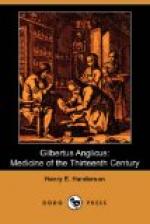Actual diseases of the eye are discussed in chapters on pain in the eyes, ophthalmia, pannus (including ungula, egilops and cataract), tumors of the conjunctiva, itching of the eyes, lachrymation, cancer, diseases of the cornea and uvea, diseases of the eyelids, lachrymal fistula and entropion. The treatment consists generally in ointments and collyria in abundance, but in fistula lachrymalis incision and tents of alder-pith, mandragora (malum terrae), briony, gentian, etc., are recommended, and entropion is referred directly to the surgeon.
The Latin term cataracta (also catarracta and catarractes) is applied to a disease of the eyes by Gregory of Tours (Hist. Franc., v. 6) as early as A.D. 650, and again by Constantine Africanus, of the school of Salernum, in 1075 (De Chirurg., cap. XXX). Singularly the word is not found in the “Chirurgia” of Roger of Parma, from whom Gilbert seems to have borrowed most of his surgical knowledge. Nor is it employed by Roland, Roger’s pupil and editor. It recurs, however, in the Glossulae Quatuor Magistrorum (about 1270). But in all these writers cataracta seems to be included under the general term pannus, meaning opacities of every kind. Indeed Gilbert says, “Ungula, egilops, cataracta and macula are species of pannus, all arising from the same causes and cured by the same treatment.” A few lines later, however, in distinguishing these various species, he adds: “Cataract arises from a humor collected between the tunics of the eye”: and again it is said to be blood filling the veins of the eyes, and especially those of the conjunctiva, and derives its name a caracteribus (?). The truth is none of these writers seem to have any very definite knowledge of the distinction between the various opacities of the media of the eye, all of which were included under the general term pannus. But, what is more remarkable, Roger, Roland and The Four Masters make no mention of the possibility of surgical interference in these cases, but content themselves with elaborate collyria and ointments, or simply with internal treatment. Gilbert, on the other hand, while recommending these collyria and ointments, and even the internal remedies, adds the following:
“Interior autem macula, quae tela vocatur, subcornea situata, si vl’e (?) purgatione precendente et colliriis et pulveribus non removetur, acu torta immissa per caprinum angulum extrahatur aut inferius replicetur” (f. 137a).
And again (f. 141d):
“In uvea sunt largitas et constrictio et aqua sive cataracta.... Aqua quandoque per medium pupille descendit, inferius stans, subuvea apparens, quae perfecte curatur secundum quosdam immisso acus aculeo per pupillam, ut extra fluat aqua.”
Chapters on the physiology of hearing, smelling and the sensation of touch are followed by a discussion of the symptoms and treatment of earache, abscess of the ear, discharges (bloody and sanious) from the ear, worms and other foreign bodies in the ear, tinnitus aurium, deafness, coryza, epistaxis, nasal polypi, ozaena, cancer of the nose, fissures and ulcers of the lips, foul breath, diseases of the tongue, toothache, etc.




